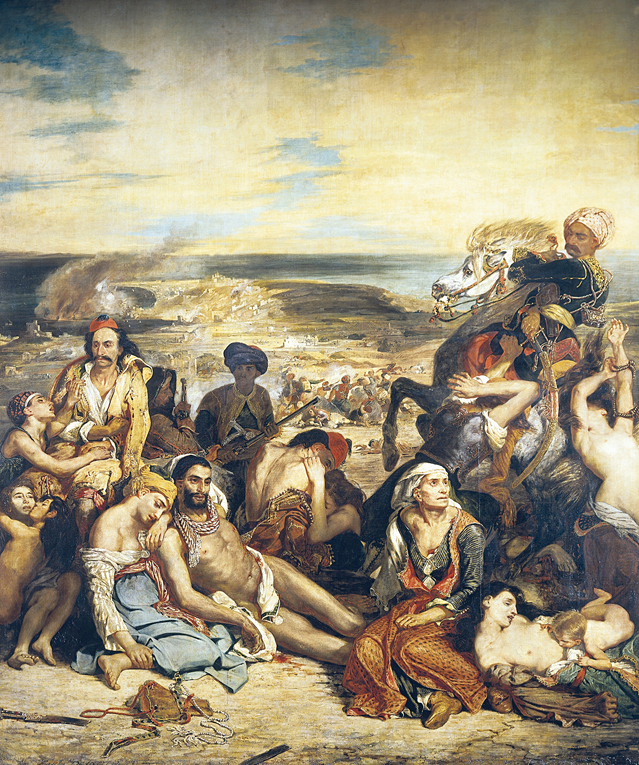A History of World Societies:
Printed Page 742
A History of World Societies Value
Edition: Printed Page 570
Chapter Chronology
Cultural Shifts

Delacroix, Massacre at Chios The Greek struggle for freedom and independence won the enthusiastic support of liberals, nationalists, and romantics. The Ottoman Turks were portrayed as cruel oppressors who were holding back the course of history, as in this moving masterpiece by Delacroix. (De Agostini Picture Library/akg-images)
The French Revolution kindled the belief that radical reconstructions of politics and society were also possible in cultural and artistic life. The most significant expression of this belief in the early nineteenth century was the romantic movement. In part a revolt against what was perceived as the cold rationality of the Enlightenment, romanticism was characterized by a belief in emotional exuberance, unrestrained imagination, and spontaneity in both art and personal life. Romanticism had forerunners in the eighteenth century, for example in the thought of Jean-Jacques Rousseau (see “The Influence of the Philosophes” in Chapter 19). It crystallized fully in the 1790s, primarily in England and Germany, and gained strength until the 1840s. Preoccupied with emotional excess, romantic works explored the awesome power of love and desire and of hatred, guilt, and despair. Where Enlightenment thinkers embraced secularization and civic life, romantics delved into religious ecstasy and the hidden recesses of the self. The romantics were passionately moved by nature and decried the growth of modern industry and grimy industrial cities.
One of the greatest and most moving romantic painters in France, Eugène Delacroix (oo-ZHEHN deh-luh-KWAH) (1798–1863), depicted dramatic, colorful scenes that stirred the emotions. He frequently painted non-European places and people, whether lion hunts in Morocco or dreams of languishing, sensuous women in a sultan’s harem. Like other romantic works, Delacroix’s art reveals the undercurrents of desire and fascination within Europe’s imperial ambitions in “exotic” and “savage” places in the nineteenth century.
It was in music that romanticism realized most fully and permanently its goals of free expression and emotional intensity. Abandoning well-defined structures, the great romantic composers used a wide range of forms to create musical landscapes and evoke powerful emotion. The first great romantic composer is among the most famous today, Ludwig van Beethoven (1770–1827). As a contemporary admirer wrote, “Beethoven’s music sets in motion the lever of fear, of awe, of horror, of suffering, and awakens just that infinite longing which is the essence of Romanticism.”
Romanticism also found a distinctive voice in poetry. William Wordsworth (1770–1850) was the towering leader of English romanticism. In 1798 Wordsworth and his fellow romantic poet Samuel Taylor Coleridge (1772–1834) published their Lyrical Ballads, which abandoned flowery classical conventions for the language of ordinary speech. Wordsworth described his conception of poetry as the “spontaneous overflow of powerful feeling recollected in tranquility.”
Victor Hugo (1802–1885) was France’s greatest romantic master in both poetry and prose. His powerful novels exemplified the romantic fascination with fantastic characters, strange settings, and human emotions. The hero of Hugo’s famous Hunchback of Notre Dame (1831) is the great cathedral’s deformed bell-ringer, a “human gargoyle” overlooking the teeming life of fifteenth-century Paris.
The study of history became a romantic passion. History was the key to a universe that was now perceived to be organic and dynamic, not mechanical and static as the Enlightenment thinkers had believed. Historical studies supported the development of national aspirations and encouraged entire peoples to seek in the past their special destinies.
In central and eastern Europe, in particular, literary romanticism and early nationalism reinforced each other. Like modern anthropologists, romantics turned their attention to peasant life and transcribed the folk songs, tales, and proverbs that the cosmopolitan Enlightenment had disdained. The brothers Jacob and Wilhelm Grimm were particularly successful at rescuing German fairy tales from oblivion. In the Slavic lands romantics played a decisive role in converting spoken peasant languages into modern written languages. The greatest of all Russian poets, Aleksandr Pushkin (1799–1837), used his lyric genius to mold the modern literary language of Russia.
Beginning in the 1840s romanticism gave way to a new artistic genre, realism, which continued to dominate Western culture and style until the 1890s. Influenced by the growing prestige of science in this period, realist writers believed that literature should depict life exactly as it is. Forsaking poetry for prose and the personal, emotional viewpoint of the romantics for strict scientific objectivity, the realists simply observed and recorded.
Rejecting the romantic search for the exotic and the sublime, realist writers focused on creating fiction based on contemporary everyday life. Beginning with a dissection of the middle classes, from which most of them sprang, many realists eventually focused on the working classes, especially the urban working classes, which had been neglected in literature before this time. The realists put a microscope to unexplored and taboo topics — sex, strikes, violence, alcoholism — shocking middle-class critics. Madame Bovary, by Gustave Flaubert (1821–1880), for example, describes the heroine’s adulterous affairs and lavish spending as she seeks to escape a dull husband and banal existence in a small provincial village. Although the novel is now considered one of the greatest ever written, public prosecutors charged Flaubert with obscenity when it first appeared in 1856.
The realists’ claims of objectivity did not prevent the elaboration of a definite worldview. Realists such as the famous French novelist Émile Zola (1840–1902) and English novelist Thomas Hardy (1840–1928) were determinists. They believed that human beings, like atoms, are components of the physical world and that all human actions are caused by unalterable natural laws: heredity and environment determine human behavior; good and evil are merely social conventions. They were also critical of the failures of industrial society; by depicting the plight of poor workers, they hoped to bring about positive social change.
